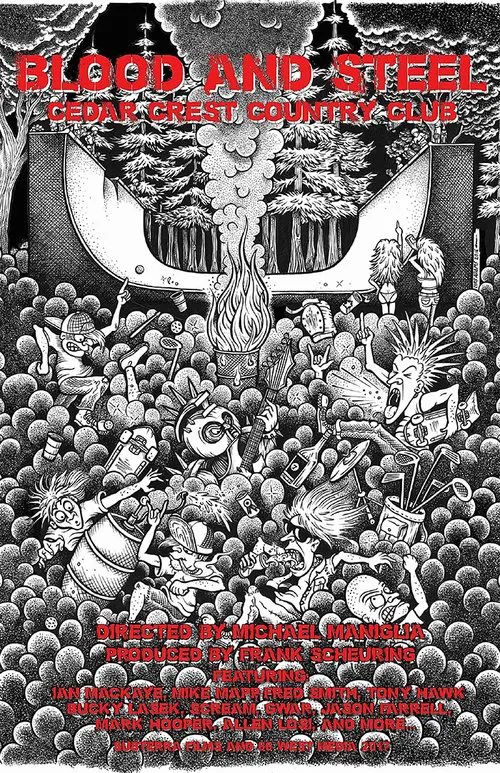Blood and Steel: Cedar Crest Country Club

Plot
It's the early 1980s in the Washington D.C. suburbs, and the nation's capital is a far cry from the skateboarding and punk rock mecca that's emerging in the small, secluded town of Cedar Crest. Nestled in a serene country club, Cedar Crest would soon become the epicenter of a revolutionary movement that would forever change the face of skateboarding and punk rock. The story begins with a small group of passionate and ambitious individuals who share a common love for both skateboarding and music. They are a bunch of rebels who refuse to conform to the conventional norms of their suburban community. Led by the charismatic and fearless Alex, these young outcasts find solace in the Cedar Crest Country Club, a place once reserved for the privileged few of their town's upper class. Initially, the country club is nothing more than a neglected relic of a bygone era, left abandoned and untouched by the world outside. But for the group, it represents a blank canvas, just waiting to be transformed into something truly special. As they begin to occupy the premises, they start to bring their vision to life. The old tennis courts become the site of the most daring skateboarding stunts, while the abandoned swimming pool starts to take shape as a makeshift music venue. The group sets up a state-of-the-art sound system, and their love for punk rock music is palpable as they organize impromptu jams and concerts, with local and visiting bands sharing the stage. Before long, word begins to spread about the underground skateboarding and music scene at Cedar Crest. Professional skaters from all over the country start to make the trek to the country club, drawn by the rumors of a place that truly understands their passion. Legendary bands like Minor Threat, Bad Brains, and The Replacements find themselves at home in the midst of Cedar Crest's rebellious spirit. As the scene continues to grow, the boundaries between skateboarding and music start to blur. Skaters like Mark Gonzales and Rodney Mullen push the limits of what's thought possible on a skateboard, while bands like Black Flag and T.S.O.L. channel the raw energy and rebelliousness of the skateboarding community into their music. In this idyllic bubble of creative freedom, Cedar Crest becomes a true sanctuary for those who refuse to conform. It's a place where the lines between reality and fantasy are blurred, and where the possibilities are endless. Here, the skaters and musicians live and breathe the thrill of the moment, constantly pushing the limits of what's possible. As the movement gathers momentum, tensions between the Cedar Crest crew and the local authorities start to escalate. The police begin to crack down on the scene, trying to shut it down for good. But the group refuses to back down, convinced that their creative expression is worth fighting for. The movie climaxes with a massive showdown between the police and the Cedar Crest crew. As the authorities attempt to dismantle the scene, the skaters and musicians put up a fierce resistance. In the chaos that ensues, the boundaries between music and skateboarding blur, and the true essence of the movement is revealed. In the end, Cedar Crest emerges victorious, its spirit of nonconformity and rebellion forever etched into the history books. As the curtain closes, the country club is left transformed, a testament to the power of creative freedom and the unadulterated expression of a generation. The story of Cedar Crest serves as a powerful reminder of the transformative power of art and music. As the credits roll, one cannot help but feel a deep sense of nostalgia for a bygone era, where creativity and rebellion knew no bounds. It's a story that will forever be etched in the annals of skateboarding and punk rock history, a testament to the enduring legacy of a true skateboarding mecca, "The Crest".
Reviews
Recommendations



